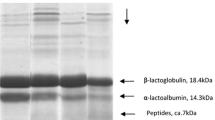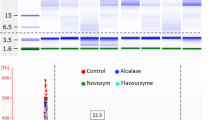Abstract
Whey protein concentrates containing 50 and 60% protein were manufactured and were hydrolyzed for 0.5, 1, 2, 3, 4, and 5 h with 5 commercial enzymes (flavourzyme, protease A, protease M, protease S, and trypsin). Functional properties such as degree of hydrolysis (DH), non-protein-nitrogen (NPN), 5-hydroxymethyl-2-furfural (HMF), solubility, and free-sulfhydryl (FSH) levels were measured. In food applications functional efficiency of whey protein hydrolysates (WPHs) depended on hydrolysis time, protein composition and enzymatic specificity. WPHs treated with protease A were found to be suitable for applications that require extensively hydrolyzed (<2 h) WPHs, because they had high solubility, DH, HMF, and FSH contents. Proteases S and M hydrolysates delayed the Maillard reaction and had high DH in mild hydrolysates (≤2 h) of WPHs. Aggressive hydrolyzed WPHs of protease A, and mild hydrolysates of proteases S and M are preferred in beverage fortification for maximum functional efficiency.
Similar content being viewed by others
References
Keowmaneechai E, McClements DJ. Influence of EDTA and citrate on thermal stability of whey protein stabilized oil-in-water emulsions containing calcium chloride. Food Res. Int. 39: 230–239 (2006)
Gowda LR, Rao ARGRA, Prakash V. Process for the preparation of angiotensin converting enzyme (ACE) inhibitors and its use. U.S. Patent 7,125,702 B2 (2006)
Prieto CA, Guadix EM, Guadix A. Recent patents on whey protein hydrolysates manufactured by proteolysis coupled to membrane ultrafiltration. Recent Pat. Chem. Eng. 3: 115–128 (2014)
Haque ZU, Bohoua GL,Williams J, Mikel WB. Influence of whey peptides on the surface activity of êcasein and âlactoglobulin A. Int. J. Dairy Technol. 63: 190–196 (2010)
Jeewanthi RKC, Paik HD, Kim MH, Lee NK, Kim SY, Yoon YC. Characteristics of whey protein hydrolysates from cheese whey, favors on various food applications. Chem. Ind. Chem. Eng. Q. 20: 501–509 (2014)
Zhu D, Damodaran S, Lucey JA. The formation of WPIdextran conjugates in aqueous solutions. J. Agr. Food Chem. 56: 7113–7118 (2008)
Silvestre MPC, Morais HA, Silva VDM, Silva MR. Degree of hydrolysis and peptide profile of whey proteins using pancreatin. Nutrire 38: 278–290 (2013)
LaClair CE, Etzel MR. Turbidity and protein aggregation in whey protein beverages. J. Food Sci. 74: C526–C535 (2009)
Bastos DM, Monaro E, Siguemoto E, Sefora M. Maillard reaction products in processed food: Pros and cons. pp. 282–300. In: Food Industrial Processes-methods and Equipment. Benjamin Valdez (ed). InTech, Rijeka, Croatia (2012)
Yu A, Zhang A. The effect of pH on the formation of aroma compounds produced by heating a model system containing Lascorbic acid with L-threonine/L-serine. Food Chem. 119: 214–219 (2010)
Akram A, Sohail A, Masud T, Latif A, Tariq S, Butt SJ, Hassan I. Physico-chemical and antimicrobial assessment of honey of Apis dorsata from different geographical regions of Pakistan. Int. J. Agric. Sci. Res. 3: 25–30 (2014)
Owusu-Apenten R. Colorimetric analysis of protein sulfhydyl groups in milk: Applications and processing effects. Crit. Rev. Food Sci. 45: 1–23 (2005)
Jayaprakasha HM, Yoon YC. Production of functional whey protein concentrate by monitoring the process of ultrafiltration. Asian Austral. J. Anim. 18: 433–438 (2005)
AOAC. Official Methods of Analysis of the Association of Official Analytical Chemists. 17th ed. Method 991.20. Association of Official Analytical Chemists, Washington, DC, USA (2002)
Adler-Nissen J. Determination of the degree of hydrolysis of food protein hydrolysates by trinitrobenzenesulfonic acid. J. Agr. Food Chem. 27: 1256–1262 (1979)
Lowry OH, Rosebrough NJ, Farr AL, Randall RJ. Protein measurement with the folin phenol reagent. J. Biol. Chem. 193: 265–275 (1951)
Keeney M, Bassette R. Detection of intermediate compounds in the early stages of browning reaction in milk products. J. Dairy Sci. 42: 945–960 (1959)
Riener CK, Kada G, Gruber HJ. Quick measurement of protein sulfhydryls with Ellman’s reagent and with 4,4-dithiodipyridine. Anal. Bioanal. Chem. 373: 266–276 (2002)
Panyam D, Kilara A. Enhancing the functionality of food proteins by enzymatic modification. Trends Food Sci. Tech. 7: 120–125 (1996)
Kamau SM, Lu R. The effects of hydrolysis conditions on degree of hydrolysis and DPPH of radical scavenging activity of whey protein hydrolysates. Curr. Res. Dairy Sci. 3: 25–35 (2011)
Shankar S. Stability of protease in organic solvents, detergents and denaturants (Chapter 1). PhD thesis, Savitribai Phule Pune University, Pune, India (2010)
Arribas-Lorenzo G, Morales FJ. Estimation of dietary intake of 5- hydroxymethylfurfural and related substances from coffee to Spanish population. Food Chem. Toxicol. 48: 644–649 (2010)
Sharma A, Jana AH, Chavan RS. Functionality of milk powders and milk-based powders for end use applications-A review. Compr. Rev. Food Sci. F. 11: 518–528 (2012)
Mehta A. Microbial proteases and their applications. pp. 199–226. In: Industrial Exploitation of Microorganisms. Maheshwari DK, Dubey RC, Sarvanamurthu R (eds). I. K. International Publishing House Pvt. Ltd., New Delhi, India (2010)
Lim SM, Lee NK, Park KK, Yoon YC, Paik HD. ACE-inhibitory effect and physicochemical characteristics of yogurt beverage with whey protein hydrolysates. Korean J. Food Sci. An. 31: 886–892 (2011)
Ward OP, Rao MB, Kulkarni A. Proteases, production. pp. 495–511. In: Encyclopedia of Microbiology. 3rd edition. Moselio Schaechter (ed). Academic Press, Waltham, MA, USA (2009)
Author information
Authors and Affiliations
Corresponding author
Rights and permissions
About this article
Cite this article
Kankanamge, R., Jeewanthi, C., Lee, NK. et al. Physicochemical characterization of hydrolysates of whey protein concentrates for their use in nutritional beverages. Food Sci Biotechnol 24, 1335–1340 (2015). https://doi.org/10.1007/s10068-015-0171-3
Received:
Revised:
Accepted:
Published:
Issue Date:
DOI: https://doi.org/10.1007/s10068-015-0171-3




